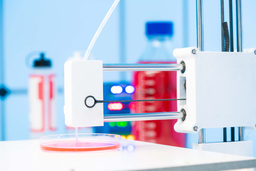Acoustically-Responsive Bioinks for Extrusion-Based 3D-Bioprinting
TECHNOLOGY NUMBER: 2022-091

OVERVIEW
An improved method of bioprinting for use in regenerative medicine- Optimized fabrication of acoustically responsive scaffolds (ARSs)
- Improved tissue micromechanics and biological functioning
BACKGROUND
Bioprinting is a form of three-dimensional (3D) printing that can engineer human tissues such as bone, blood vessels, and organ prostheses for various medical applications. The technology is critical for success in regenerative medicine, a specialty that seeks to replace tissues damaged by disease, trauma, or the sequelae of congenital illnesses. Two of the goals of regenerative medicine are to recreate the biochemical and physical complexities of the normal human extracellular matrix within engineered constructs. The use of computer-aided design (CAD) and the advent of extrusion-based bioprinting have aided researchers and clinicians in their efforts. Bioprinting involves precise layer-by-layer deposition of biomaterials and biological components to form structures critical to regenerative medicine. However, the release of biological molecules in bioprinted hydrogels is governed by mechanisms such as diffusion and degradation, and a need exists for hydrogels that respond to an externally controlled stimulus in a user-defined, spatiotemporally controlled manner.
INNOVATION
Researchers at the University of Michigan have developed 3D-printable, acoustically responsive bioinks that enable fabrication of acoustically responsive scaffolds (ARSs) with precise micropatterned phase shift emulsions (PSEs) which optimize print fidelity. This novel process involves exposure of the printer's emulsion droplets to ultrasound which creates small gas bubbles in the hydrogel matrix to create a product that has improved tissue micromechanics and biological functioning. The improved alignment of fibrin fibers through the use of this approach likely contributed to its success. These bioprinted ASRs provide favorable properties compared to existing approaches, including the production of more complex geometries and therefore better personalized prints for use in regenerative medicine. This new form of bioprinting will likely aid in optimizing ARSs for a variety of therapeutic applications.